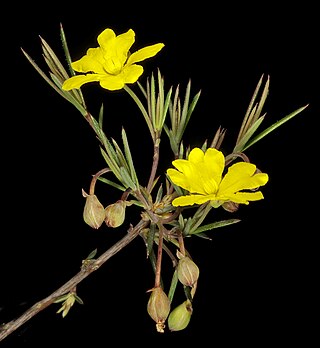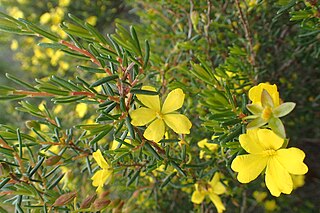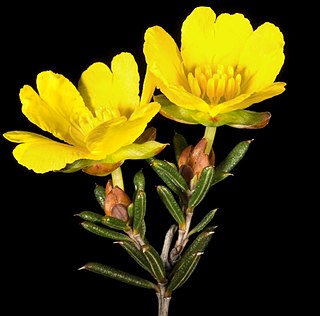
Hibbertia hypericoides, commonly known as yellow buttercups, is a species of flowering plant in the family Dilleniaceae and is endemic to the south-west of Western Australia. It is usually a spreading shrub with linear to elliptic or egg-shaped leaves, and yellow flowers, usually with ten to fifteen stamens arranged in a cluster on one side of the two densely hairy carpels.

Hibbertia vestita, commonly known as hairy guinea-flower, is a species of flowering plant in the family Dilleniaceae and is endemic to eastern Australia. It is a small shrub with foliage covered with simple hairs, usually linear leaves, and yellow flowers with 22 to 43 stamens with many staminodes arranged around three hairy carpels.

Hibbertia acerosa, commonly known as needle leaved guinea flower, is a species of flowering plant in the family Dilleniaceae and is endemic to the south-west of Western Australia. It is a low, spreading or ascending shrub typically growing to a height of 10–60 cm (3.9–23.6 in) and has yellow flowers from July to December or from January to February.
Hibbertia crassifolia is a shrub in the Dilleniaceae family and is endemic to Western Australia. It is an erect shrub with multiple stems that typically grows to a height of 0.2 to 0.6 m but can reach 0.9 m. It blooms between April and September and produces yellow flowers. The species has a scattered distribution through the western Wheatbelt region of Western Australia between Three Springs in the north, Ballidu in the east and Wandering in the south where it is found on sandplains and breakaways growing in sandy lateritic soils.
Hibbertia dealbata is a species of flowering plant in the family Dilleniaceae and is endemic to northern Australia. It is an erect shrub that typically grows to a height of up to 2 m. It is similar to Hibbertia brownii but has lance-shaped to egg-shaped leaves with the lower end towards the base and flattened hairs on the lower surface. The flowers are arranged on the ends of the branchlets.
Hibbertia echiifolia is a species of flowering plant in the family Dilleniaceae and is endemic to northern Australia. It is a variable shrub with elliptic to lance-shaped or oblong leaves and yellow flowers arranged singly in leaf axils, with twenty-nine to forty-five stamens arranged around the three carpels.

Hibbertia glomerata is a species of flowering plant in the family Dilleniaceae and is endemic to the south-west of Western Australia. It is a much-branched shrub with mostly oblong or egg-shaped to elliptic leaves and yellow flowers borne on the ends of short side shoots, with nine to twelve stamens, sometimes in groups of three, arranged around the three carpels.

Hibbertia glomerosa is a species of flowering plant in the family Dilleniaceae and is endemic to the south-west of Western Australia. It is a shrub with linear to narrow oblong leaves and bright yellow flowers borne on the ends of short side shoots, with twenty-five to thirty-eight stamens arranged in groups of five around the five glabrous carpels.

Hibbertia gracilipes is a species of flowering plant in the family Dilleniaceae and is endemic to the south-west of Western Australia. It is an erect, multi-stemmed shrub that typically grows to a height of 15–60 cm (5.9–23.6 in). It blooms between March and December producing yellow flowers. First formally described in 1863 by George Bentham in Flora Australiensis, the specific epithet (gracilipes) means "thin foot", referring to the peduncles.

Hibbertia inclusa is a species of flowering plant in the family Dilleniaceae and is endemic to the south-west of Western Australia. It is an erect, spreading shrub that typically grows to a height of 20–90 cm (7.9–35.4 in). It was first formally described in 1863 by George Bentham in Flora Australiensis from specimens collected from the Swan River Colony by James Drummond. The specific epithet (inclusa) means "enclosed", referring to the flowers being enclosed in floral bracts.

Hibbertia lasiopus is a species of flowering plant in the family Dilleniaceae and is endemic to the south-west of Western Australia. It is prostrate, ascending sometimes erect shrub that typically grows to a height of 10–50 cm (3.9–19.7 in). It was first formally described in 1863 by George Bentham in Flora Australiensis from specimens collected from the Swan River Colony by James Drummond. The specific epithet (lasiopus) means "shaggy foot", referring to the flowers' hairy peduncles.
Hibbertia ledifolia is a species of flowering plant in the family Dilleniaceae and is endemic to the Kimberley region of Western Australia. It is an erect shrub that typically grows to a height of 1–2 m and has yellow flowers from April to June. It was first formally described in 1863 by George Bentham in Flora Australiensis from specimens collected from York Sound by Allan Cunningham. The specific epithet (ledifolia) means "Ledum-leaved", referring to the broom-like shape of the shrub.

Hibbertia leptopus is a species of flowering plant in the family Dilleniaceae and is endemic to Western Australia. It is an erect shrub with linear leaves and yellow flowers, usually with eleven stamens arranged around the three carpels.

Hibbertia linearis is a species of flowering plant in the family Dilleniaceae and is endemic to eastern Australia. It is a shrub with linear to oblong or egg-shaped leaves and yellow flowers with 15 to 25 stamens arranged around the three carpels.
Hibbertia nutans, commonly known as nodding guinea flower, is a species of flowering plant in the family Dilleniaceae and is endemic to the south-west of Western Australia. It is an erect shrub that typically grows to a height of 0.2–1.0 m and flowers between August and October producing yellow flowers. It was first formally described in 1863 by George Bentham in Flora Australiensis from specimens collected in 1843 by James Drummond in the Swan River Colony. The specific epithet (nutans) means "nodding".

Hibbertia polystachya is a species of flowering plant in the family Dilleniaceae and is endemic to the south-west of Western Australia. It is an erect to sprawling or straggly shrub with narrow elliptic to linear leaves and yellow flowers arranged in groups of up to five with about ten stamens and a similar number of staminodes, arranged on one side of two hairy carpels.

Hibbertia potentilliflora is a species of flowering plant in the family Dilleniaceae and is endemic to the west of Western Australia. It is an erect or low-lying shrub that typically grows to a height of 15–60 cm (5.9–23.6 in) and has yellow flowers. It was first formally described in 1863 by George Bentham in Flora Australiensis from specimens collected from the Swan River Colony by James Drummond and from near the Murchison River by Augustus Oldfield. The specific epithet (potentilliflora) means "Potentilla-flowered".

Hibbertia pungens is a species of flowering plant in the family Dilleniaceae and is endemic to Western Australia. It is a prickly, erect or sprawling shrub that typically grows to a height of 0.2–2.0 m and produces uniformly yellow flowers between June and November. It was first formally described in 1863 by George Bentham in Flora Australiensis. The specific epithet (pungens) means "ending in a sharp point".

Hibbertia ulicifolia is a species of flowering plant in the family Dilleniaceae and is endemic to the south-west of Western Australia. It is an erect shrub that typically grows to a height of 0.2–1 m.

Hibbertia vaginata is a species of flowering plant in the family Dilleniaceae and is endemic to the south-west of Western Australia. It is an erect, spreading shrub that typically grows to a height of 20–75 cm (7.9–29.5 in).















